Your garden serves as nature’s welcome mat, inviting South Carolina’s wildlife to thrive alongside your landscape design. You’ll discover that selecting the right native plants isn’t just about beauty—it’s about creating a sustainable ecosystem that requires 40% less water and maintenance than non-native alternatives. These regional champions, from towering 80-foot Live Oaks to delicate 6-inch Wild Gingers, hold secrets that’ll transform your outdoor space into something extraordinary.
Contents
- 1 South Carolina’s Diverse Climate Zones
- 2 Best Native Blooms Selection
- 3 Signature Native Shade Trees
- 4 Essential Native Shrubs for Landscaping
- 5 Selecting the Right Native Plants for Your Garden
- 6 Frequently Asked Questions
- 6.1 How Much Do Native South Carolina Plants Typically Cost Compared to Non-Native Varieties?
- 6.2 When Is the Best Time of Year to Plant Native Species?
- 6.3 How Often Should I Water Newly Planted Native South Carolina Plants?
- 6.4 Do Native Plants Require Special Fertilizers or Soil Amendments?
- 6.5 Where Can I Purchase Authentic South Carolina Native Plants Locally?
South Carolina’s Diverse Climate Zones
When you’re selecting native plants for your South Carolina landscape, understanding the state’s four distinct climate zones becomes your roadmap to success. Your zone determines which plants will thrive, not just survive.
The upstate mountains sit in Zone 7B, experiencing winter lows of 5°F to 10°F. Moving southeast, the Piedmont offers Zone 8A’s milder 10°F to 15°F minimums. The coastal plain’s Zone 8B rarely drops below 15°F, while the Lowcountry enjoys Zone 9B’s balmy 25°F to 30°F range.
This climate adaptability creates incredible regional biodiversity, letting you choose from mountain laurels to coastal palmettos. The USDA’s zone identification system allows you to input your zip code for precise growing zone information specific to your exact location.
Best Native Blooms Selection
South Carolina’s native flowering plants offer stunning seasonal displays while supporting local ecosystems. From early spring perennials to late-season showstoppers, these selections guarantee continuous blooms throughout growing seasons. Native plants play a crucial role in encouraging biodiversity by providing essential habitat and food sources for local wildlife, pollinators, and beneficial insects.
Carolina Jessamine
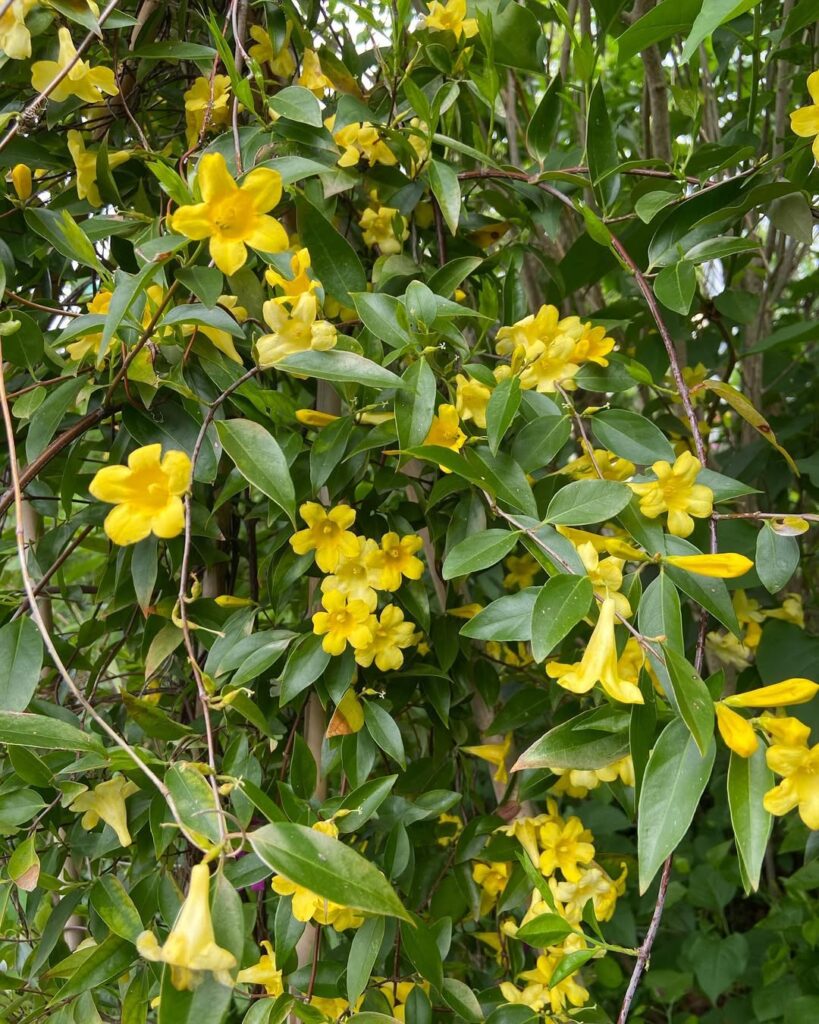
Carolina jessamine is South Carolina’s state flower and a vigorous evergreen vine that produces clusters of fragrant, trumpet-shaped yellow blooms in early spring. This high-climbing native can reach 10-20 feet when supported or form attractive groundcover when pruned annually. The showy flowers attract pollinators including bees, butterflies, and hummingbirds, making it valuable for biodiversity.
Not a true jasmine, this resilient vine thrives throughout the Southeast from Virginia to Florida. It’s commonly used to cover fences, arbors, and trees, or maintained as a 3-foot ground cover with regular trimming. The foliage develops a beautiful yellow or purple cast during winter months, adding seasonal interest to the landscape. All parts of the plant are toxic to humans and pets, so placement should be considered carefully.
- Hardiness: USDA Zones 7a-10b, hardy to 0°F-10°F
- Light: Full sun to part shade; more blooms and denser growth in full sun
- Water: Medium water needs; drought tolerant once established
- Soil: Tolerates various soil types
- Fertilizer: Annual fertilizing in early spring enhances performance
- Pest/Disease Resistance: Generally trouble-free and resilient
- Growth Rate: Vigorous growth habit
Wild Bergamot

Wild Bergamot is a striking native perennial that brings both beauty and ecological value to South Carolina gardens. This aromatic wildflower produces clusters of lavender, pink, or white pompom-like blooms from summer through fall, reaching 2-4 feet in height. Its minty-scented foliage adds fragrance to the landscape while attracting butterflies, bees, and hummingbirds.
As one of the best species for native meadows and naturalized areas, Wild Bergamot thrives in average to dry soils and offers excellent drought tolerance once established. Its deer-resistant nature and adaptability to various growing conditions make it an ideal choice for low-maintenance South Carolina landscapes seeking native plant solutions. The plant can be easily propagated through seed germination, cuttings, or division to expand your native garden display.
- Hardiness: USDA zones 3-9
- Light: Full sun to partial shade
- Water: Medium moist to dry conditions; drought tolerant but intolerant of consistently dry soil
- Soil: Well-drained, adaptable to wide range of soil types
- Fertilizer: Low requirements; benefits from native soil conditions
- Pest/Disease Resistance: Generally resistant; deer tolerant
- Growth Rate: Moderate; spreads to form colonies
Coral Honeysuckle

Coral Honeysuckle is a stunning native vine that produces vibrant red to coral tubular flowers with bright yellow interiors from spring through summer. This semi-evergreen climber features glossy foliage and a twining growth habit perfect for arbors, fences, and trellises. Unlike invasive honeysuckle varieties, this native species provides exceptional wildlife value while maintaining controlled growth.
As a major hummingbird magnet, Coral Honeysuckle also attracts butterflies and native pollinators throughout its extended blooming season. Its drought tolerance and adaptability to coastal conditions make it an ideal low-maintenance choice for South Carolina gardens seeking vertical interest and year-round appeal. After the flowering period, the vine produces berries that attract various songbirds to the garden.
- Hardiness: Zones 4-9, semi-evergreen to deciduous depending on winter severity
- Light: Full sun to partial shade
- Water: Drought tolerant once established, minimal supplemental watering needed
- Soil: Adapts well to sandy coastal soils, tolerates various soil types
- Fertilizer: Low fertility requirements, thrives in native soil conditions
- Pest/Disease Resistance: Good resistance, fewer issues than non-native honeysuckles
- Growth Rate: Moderate to fast-growing vine with controlled spread
Purple Coneflower
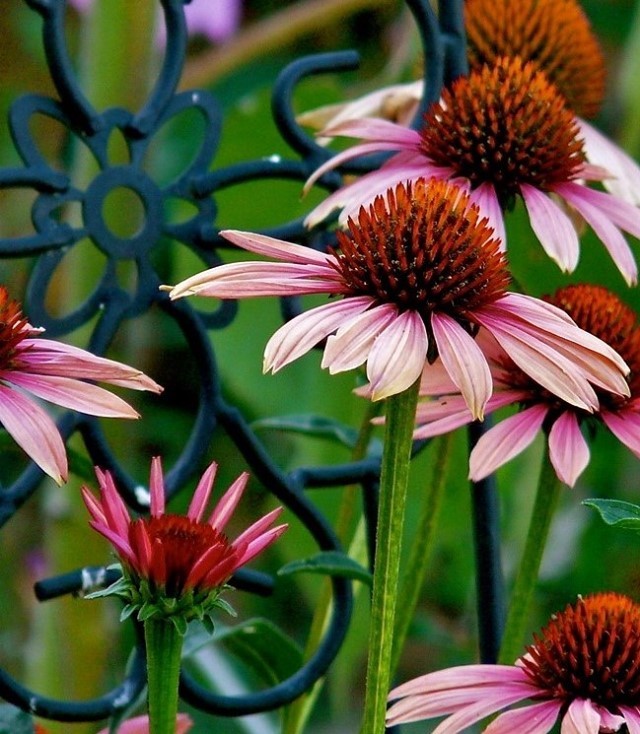
Purple Coneflower stands out as one of South Carolina’s most reliable native perennials, offering stunning purple-pink blooms from June through August. This robust plant grows 2-5 feet tall with distinctive drooping ray petals surrounding dark purplish-brown centers that provide long-lasting color. The rhizomatous perennial features coarse, lanceolate leaves and smooth stems, creating an upright cascading form that adds fine texture to landscape designs.
Beyond its ornamental value, Purple Coneflower serves as a pollinator magnet, particularly attracting butterflies while providing seeds for finches and other songbirds. Native to the Southeastern United States, this adaptable plant thrives in various conditions from full sun to partial shade and tolerates everything from moist loam to rocky, dry soils. Its drought tolerance, deer resistance, and ability to naturalize through both rhizomes and seeds make it an excellent choice for low-maintenance native gardens, borders, and naturalized areas. Conservation-minded gardeners should note that the smooth purple coneflower appears on the United States threatened and endangered species list.
- Hardiness: USDA zones 3-8
- Light: Full sun to part shade
- Water: Dry to medium moisture; drought tolerant once established
- Soil: Well-drained, moist loam preferred; adapts to clay, dry, shallow, and rocky soils
- Fertilizer: Low fertility requirements; minimal fertilization needed
- Pest/Disease Resistance: Excellent resistance to heat, humidity, salt, and deer; generally pest-free
- Growth Rate: Moderate
Wild Columbine
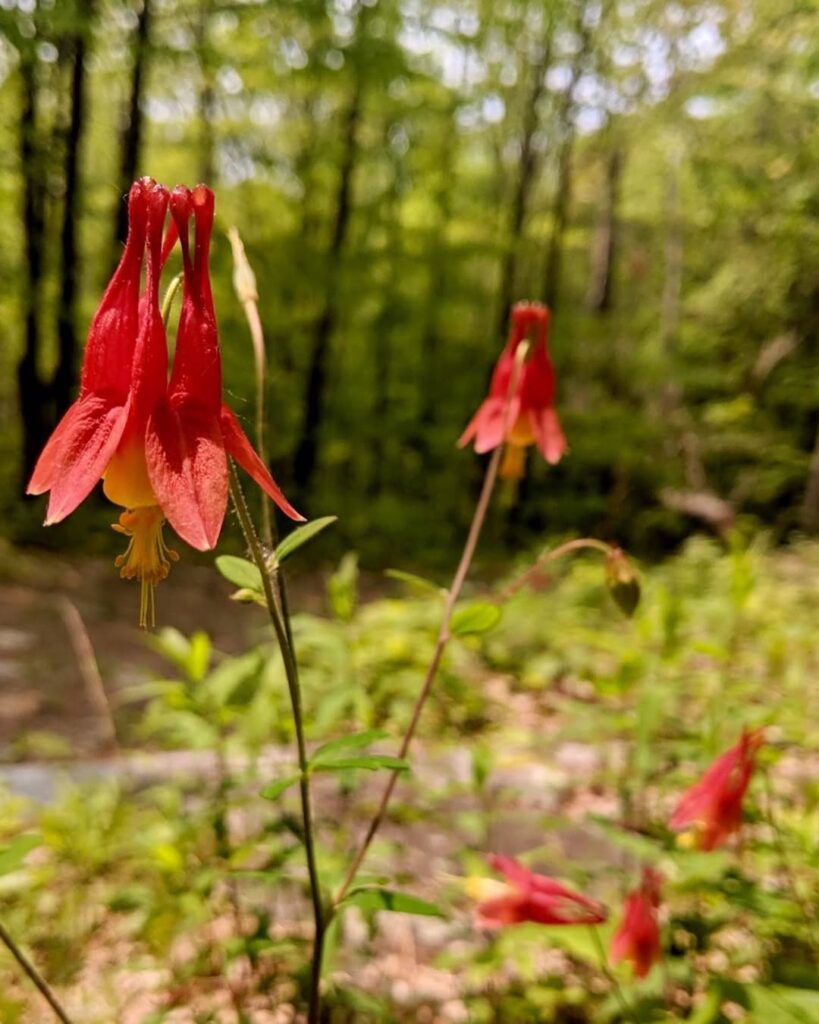
Wild Columbine is a charming native perennial that brings early spring color to South Carolina landscapes with its distinctive red and yellow spurred flowers. Growing 1-3 feet tall, this herbaceous plant features blue-green lobed foliage and showy nodding blooms from March through July. It’s particularly valued for attracting hummingbirds and early-season pollinators.
This adaptable wildflower thrives in various habitats from wooded slopes to rocky areas, making it excellent for naturalized gardens, woodland borders, and rain gardens. Wild Columbine dies back to its base in late autumn and reemerges each spring, with foliage potentially remaining semi-evergreen in milder southern winters. The plant also serves as a larval host for the Columbine Duskywing butterfly, adding to its ecological value in native landscapes.
- Hardiness: USDA zones 3-8
- Light: Full sun to partial shade
- Water: Moderate moisture; drought tolerant once established
- Soil: Well-draining loam, sand, or shallow rocky soils
- Fertilizer: Low requirements; avoid over-fertilizing
- Pest/Disease Resistance: Generally resistant with few major issues
- Growth Rate: Medium
Signature Native Shade Trees
South Carolina’s native shade trees offer unmatched beauty, adaptability, and ecological benefits, creating stunning landscapes while supporting local wildlife and thriving in regional growing conditions. These exceptional trees, including River Birch with its distinctive peeling bark and Red Maple known for vibrant fall foliage, provide both visual interest and practical shade solutions for homeowners seeking to enhance their outdoor spaces.
Southern Live Oak
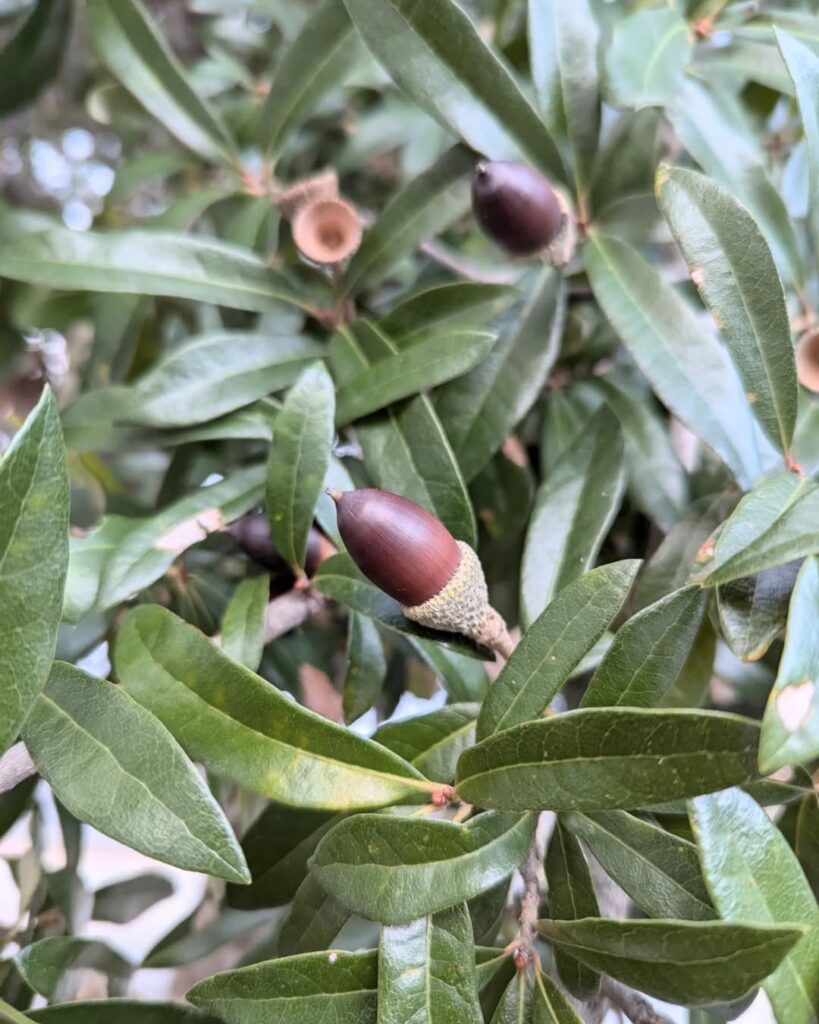
The Southern Live Oak stands as one of the most iconic and majestic native shade trees in South Carolina landscapes. With its distinctive broad, spreading crown that can span 60-120 feet and graceful drooping limbs, this evergreen oak creates dramatic architectural forms that define the southern landscape. Capable of living several centuries, mature specimens often reach 60-80 feet in height and serve as keystone species supporting diverse wildlife through acorn production and dense canopy habitat.
This resilient native thrives in the coastal plain environment, demonstrating exceptional adaptability to various growing conditions while providing invaluable ecological benefits. The tree’s robust structure resists storm damage, and its extensive canopy offers significant cooling effects and energy savings for properties. The species exhibits remarkable fire resistance due to its ability to survive crown and root damage while its dense cover discourages flammable understory growth. Beyond its practical benefits, the Southern Live Oak supports native biodiversity by hosting epiphytes like Spanish moss and providing essential food sources for birds, deer, and small mammals throughout its impressive lifespan.
- Hardiness: USDA Zones 8-10, native to coastal plain from Virginia through Texas
- Light: Full sun to partial shade, tolerant of various light levels
- Water: Drought tolerant once established, adaptable to varying moisture levels
- Soil: Highly adaptable to clay, sand, loam, alkaline, and acidic soils; salt tolerant
- Fertilizer: Generally not required; benefits from organic matter in poor soils
- Pest/Disease Resistance: Generally resistant with few serious pest or disease issues
- Growth Rate: Moderate to slow, with steady development over decades
Bald Cypress
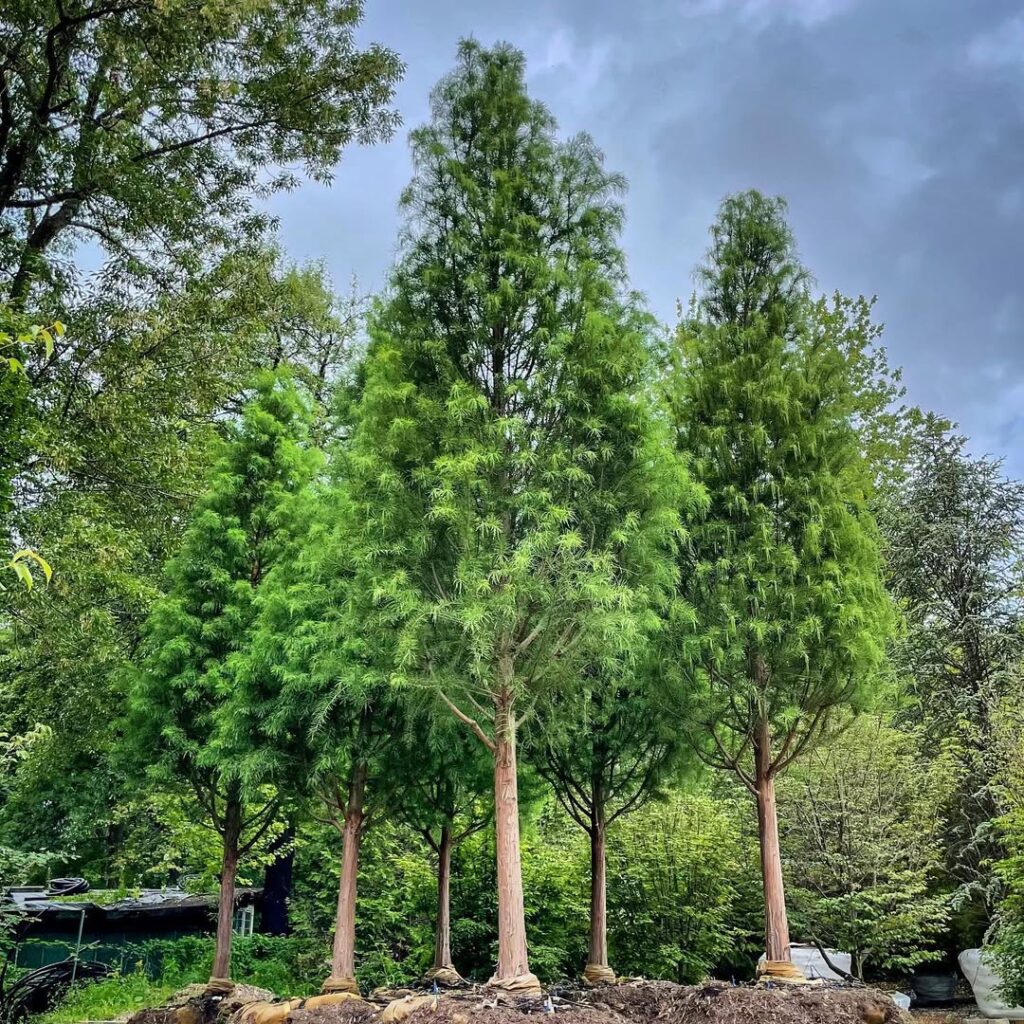
The Bald Cypress stands as one of South Carolina’s most iconic native shade trees, perfectly adapted to the state’s coastal plain wetlands. This deciduous conifer reaches 50-70 feet in cultivation, featuring a massive tapered trunk with distinctive buttressed roots and woody “knees” that emerge above water. Its soft, needle-like foliage transforms from green to stunning gold and russet-red in fall before dropping to reveal an elegant winter silhouette.
Renowned for its exceptional water tolerance and rot-resistant timber, Bald Cypress thrives in swamps, riverbanks, and floodplains throughout the southeastern United States. This long-lived native provides excellent wildlife habitat while offering dramatic seasonal interest and minimal maintenance requirements for large landscape settings. The tree exhibits moderately fast growth, typically adding 1 to 2 feet per year under optimal conditions.
- Hardiness: USDA Zones 4-9
- Light: Full sun to part shade
- Water: High; thrives in wet conditions, tolerates flooding and permanent moisture
- Soil: Adaptable to various soil types including wet, poor-draining, occasionally salty or dry soils
- Fertilizer: Low requirements; thrives without supplemental feeding
- Pest/Disease Resistance: Excellent; minimal pest and disease issues
- Growth Rate: Moderate to slow
Tulip Tree
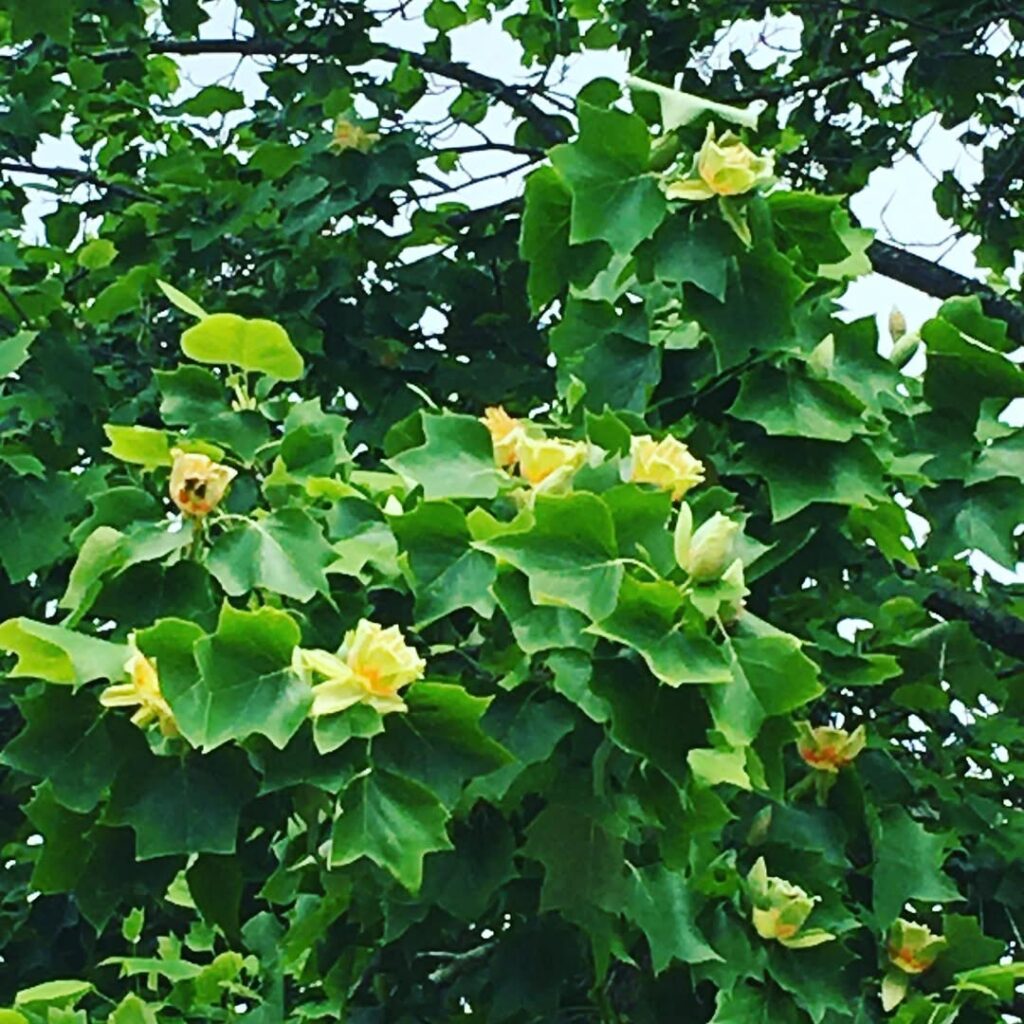
The Tulip Tree is a magnificent native shade tree that can reach heights of 80-120 feet with distinctive tulip-shaped flowers and bright yellow fall foliage. This fast-growing, long-lived species transforms from a pyramidal shape when young to an elegant oval form with maturity. While providing exceptional shade and supporting pollinators, it requires ample space and specific growing conditions to thrive.
Due to its weak wood and thin bark, the Tulip Tree needs protection from mechanical damage and isn’t suitable for confined urban spaces. It’s ideal for large landscapes and parks where its extensive root system can spread undisturbed in consistently moist, well-drained soil. The tree produces distinctive duck’s bill shaped leaves that are four-lobed with smooth margins and turn attractive colors in fall.
- Hardiness: USDA zones 4-9
- Light: Full sun to part shade
- Water: Consistently moist, drought sensitive
- Soil: Deep, well-drained loam; acidic pH 5.0-6.8; intolerant of compaction
- Fertilizer: Not specified; thrives in rich, organic soils
- Pest/Disease Resistance: Minimal insect and disease issues
- Growth Rate: Fast-growing
Southern Magnolia
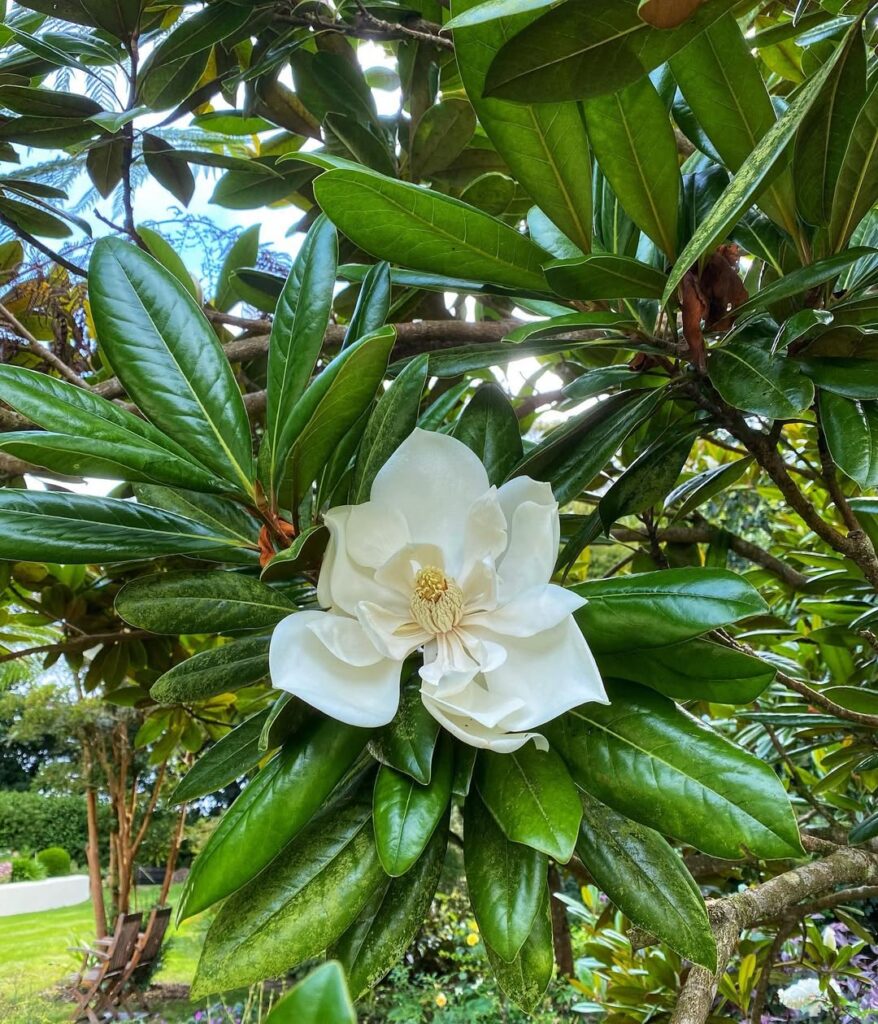
The Southern Magnolia stands as one of South Carolina’s most iconic evergreen shade trees, capable of reaching an impressive 100 feet in height with a 50-foot spread. This majestic native produces spectacular fragrant white flowers up to a foot in diameter during spring and early summer, making it a signature specimen for landscapes throughout the southeastern Coastal Plain.
As a potential climax forest species, the Southern Magnolia creates dense shade and requires adequate space for its extensive root system. While its large, slow-decomposing leaves can be messy, this fast-growing tree offers excellent fire resistance when mature and remains relatively pest-free in landscape settings. When establishing optimal growing conditions, homeowners should determine soil pH through a professional soil test available through Clemson University County Extension offices.
- Hardiness: Zones 7-10, requires 210+ frost-free days
- Light: Full sun to partial shade
- Water: Medium water needs, dry to moist soil conditions
- Soil: Rich, porous, acidic soils including sandy, loam, clay loam, or clay
- Fertilizer: Benefits from nutrient recycling of chopped fallen leaves
- Pest/Disease Resistance: Relatively pest-free in landscape settings
- Growth Rate: Fast-growing
Red Maple
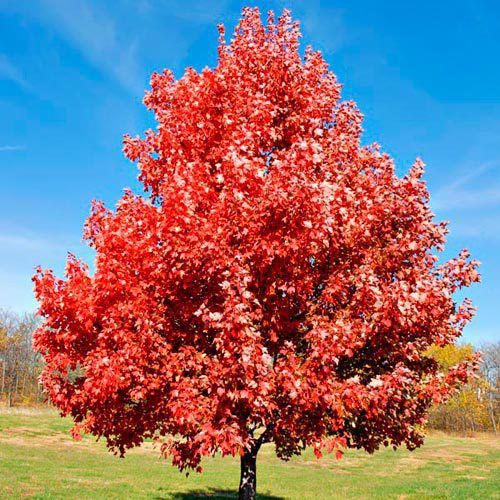
Red Maple stands as one of South Carolina’s most versatile and abundant native shade trees, reaching 30-50 feet in typical landscapes with a graceful rounded crown. This adaptable species earns its name from the striking red features displayed throughout the year – from early spring’s crimson flowers and distinctive winged fruits to the spectacular scarlet autumn foliage that makes it a premier choice for ornamental plantings.
Beyond its ornamental value, Red Maple demonstrates exceptional ecological significance as the most common deciduous tree in eastern North America. Its prolific reproductive capabilities and adaptability to diverse site conditions allow it to thrive from wetland margins to drier woodland environments, making it an ideal foundation species for South Carolina landscapes seeking both beauty and ecological function. The tree provides valuable early nectar for bees and other pollinators during late winter and early spring when few other flowering plants are available.
- Hardiness: USDA Zones 3-9, well-suited to South Carolina climate
- Light: Full sun to partial shade; shade tolerant
- Water: Adaptable from wet to moderately dry conditions; prefers consistent moisture
- Soil: Average, medium to wet, well-drained soils; highly adaptable to various soil types
- Fertilizer: Low maintenance; typically requires no supplemental fertilization
- Pest/Disease Resistance: Generally good resistance with few serious issues
- Growth Rate: Moderate to fast growth rate
Essential Native Shrubs for Landscaping
Native shrubs form the backbone of sustainable South Carolina landscapes, offering recommended species selections, versatile design applications, and significant ecological benefits for homeowners seeking low-maintenance beauty. These regionally adapted plants require less maintenance since they evolved in local climate conditions, making them ideal choices for busy gardeners.
Carolina Allspice
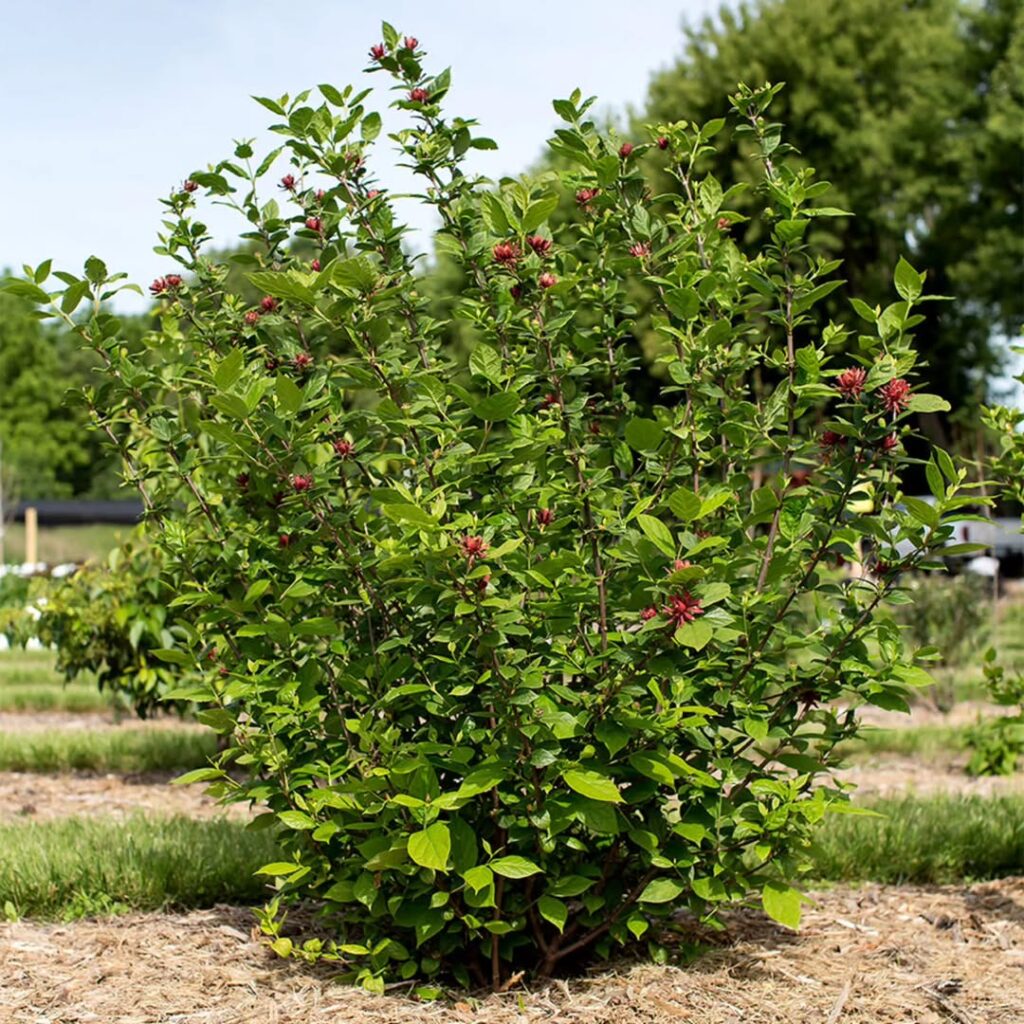
Carolina Allspice (Calycanthus floridus) is a distinctive native shrub prized for its unusual maroon to reddish-brown flowers and sweet, banana-like fragrance. This dense, rounded shrub typically reaches 6 to 9 feet in height with broad deciduous foliage. The unique strap-like flowers bloom from late spring to early summer, creating an aromatic garden experience.
This versatile shrub excels in mixed borders, informal hedgerows, and naturalistic woodland settings. Its moderate growth rate and minimal maintenance requirements make it ideal for South Carolina landscapes, while its fragrant blooms attract pollinators and add sensory appeal to any garden space. For gardeners seeking a small flowering tree in the same family, consider the native Franklinia, which produces large white blooms from mid-summer until frost.
- Hardiness: USDA zones 4-9
- Light: Full sun to partial shade
- Water: Moderate; prefers consistent moisture but tolerates some drought
- Soil: Moist, well-drained, fertile soil
- Fertilizer: Low requirements; benefits from organic matter
- Pest/Disease Resistance: Excellent; generally robust with minimal serious issues
- Growth Rate: Moderate
Southern Wax Myrtle
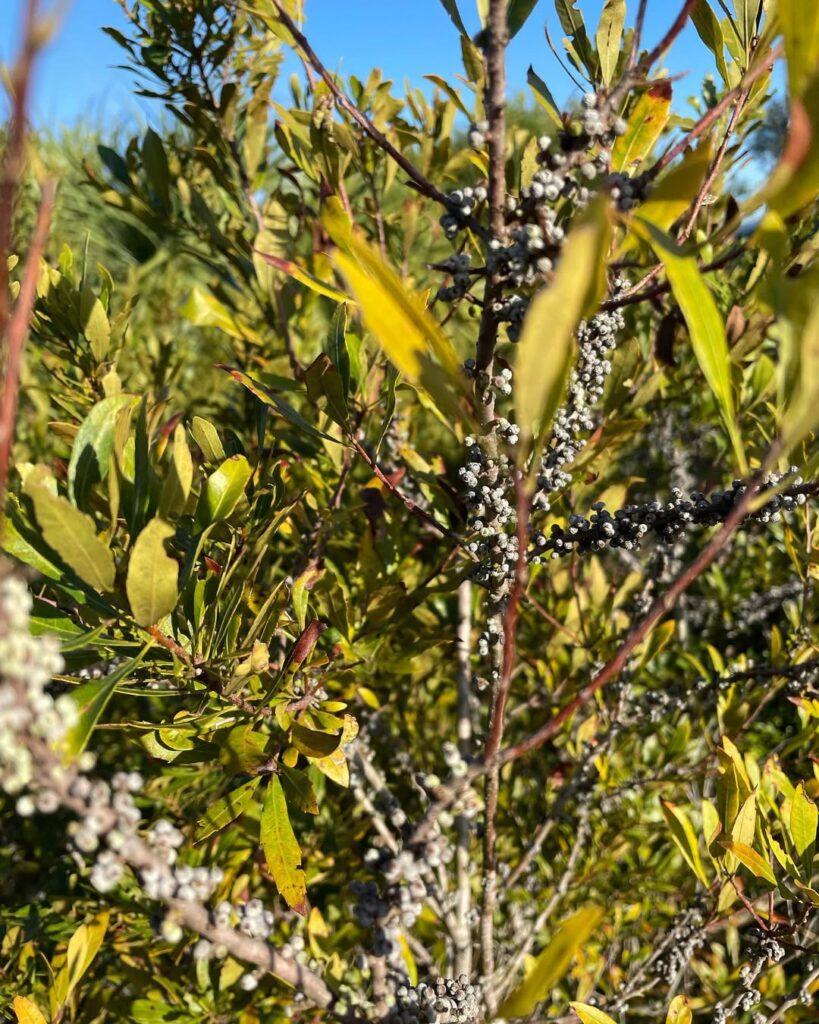
Southern Wax Myrtle is an exceptionally versatile evergreen shrub native to the southeastern United States, prized for its adaptability and low-maintenance nature. This multi-trunked plant features aromatic, olive-green foliage and attractive gray bark, typically growing 6-12 feet tall. Female plants produce small pale blue berries in winter that provide valuable wildlife food. Its remarkable tolerance to diverse conditions makes it ideal for screens, hedges, and naturalized areas in South Carolina landscapes. The plant serves as a host plant for the Red-Banded Hairstreak butterfly, making it an excellent choice for pollinator gardens.
- Hardiness: USDA zones 7-11, excellent heat tolerance but sensitive to cold winds
- Light: Full sun to partial shade
- Water: Drought tolerant once established, adaptable to wet or dry conditions
- Soil: Highly adaptable to various soil types, excellent salt tolerance
- Fertilizer: Low fertility requirements, thrives in poor soils
- Pest/Disease Resistance: Excellent resistance to most pests and diseases
- Growth Rate: Moderate to fast growth rate
Oakleaf Hydrangea

Oakleaf Hydrangea stands out as one of the few hydrangea species native to the Southeastern United States, including South Carolina. This distinctive shrub earns its name from unique oak-shaped leaves that transform into brilliant red-purple fall color. The plant produces stunning pyramidal clusters of creamy white flowers in summer that gradually fade to dusty purple, extending visual interest into early winter.
This multi-stemmed deciduous shrub reaches 8 feet tall and 6-8 feet wide, making it an excellent choice for native landscaping. Its mature branches develop attractive exfoliated bark texture, providing year-round appeal. Oakleaf Hydrangea thrives in woodland settings and naturalized areas, offering multi-season interest while supporting local wildlife including butterflies and hummingbirds. Each flower cluster contains 500-1000 flowers that serve as an important nectar and pollen source for pollinating insects.
- Hardiness: USDA zones 5-9
- Light: Full sun to part shade; requires some sun for ideal blooming
- Water: Medium moisture requirements; benefits from consistent watering
- Soil: Organically rich, well-drained soils; pH 6.8-7.2
- Fertilizer: Benefits from organic matter and mulching, especially in summer
- Pest/Disease Resistance: Generally resistant with minimal pest issues
- Growth Rate: Moderate growth rate to mature size
American Beautyberry
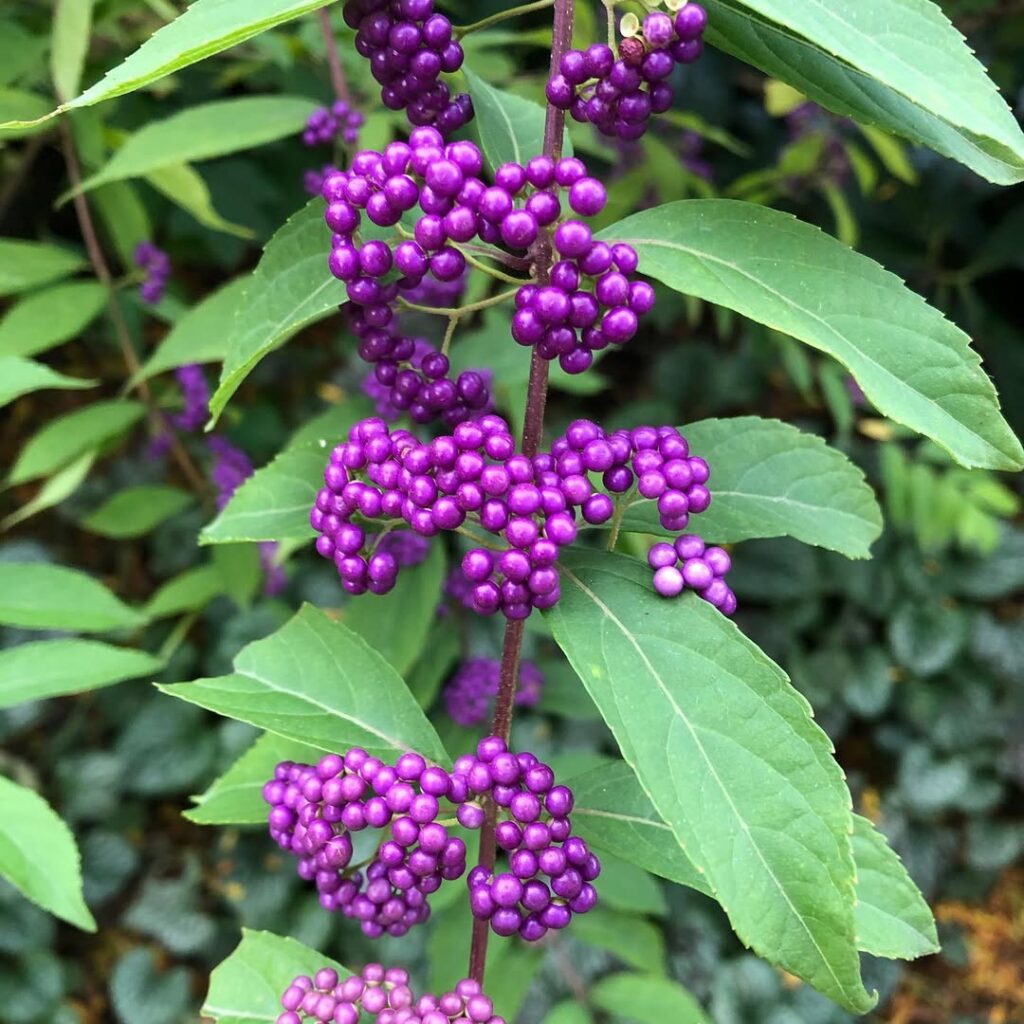
American beautyberry is a fast-growing, deciduous shrub native to the southeastern United States that reaches 3-5 feet tall and wide under typical conditions. This resilient plant features arching branches with ovate leaves and produces clusters of small pink to bluish-purple flowers in mid-summer, followed by masses of glossy, iridescent purple berries in fall.
The vibrant berry clusters persist into winter, providing valuable food for birds and wildlife when few other sources are available. Its open growth habit and tolerance for various conditions make it an excellent choice for shrub borders, understory plantings, or specimen use in South Carolina landscapes. The shrub serves as an important food source for Northern Bobwhite and other native bird species throughout the region.
- Hardiness: Zones 6-10, well-suited for South Carolina’s climate
- Light: Full sun to partial shade; ideal fruiting occurs in full sunlight
- Water: Drought tolerant once established; prefers consistently moist, well-drained soil
- Soil: Adaptable to various soils; prefers fertile, well-drained conditions with pH 4.8-7.0
- Fertilizer: Low maintenance; benefits from organic matter in soil preparation
- Pest/Disease Resistance: Excellent resistance with minimal pest or disease issues
- Growth Rate: Fast-growing with ability to recover quickly from severe pruning or damage
Wild Azalea
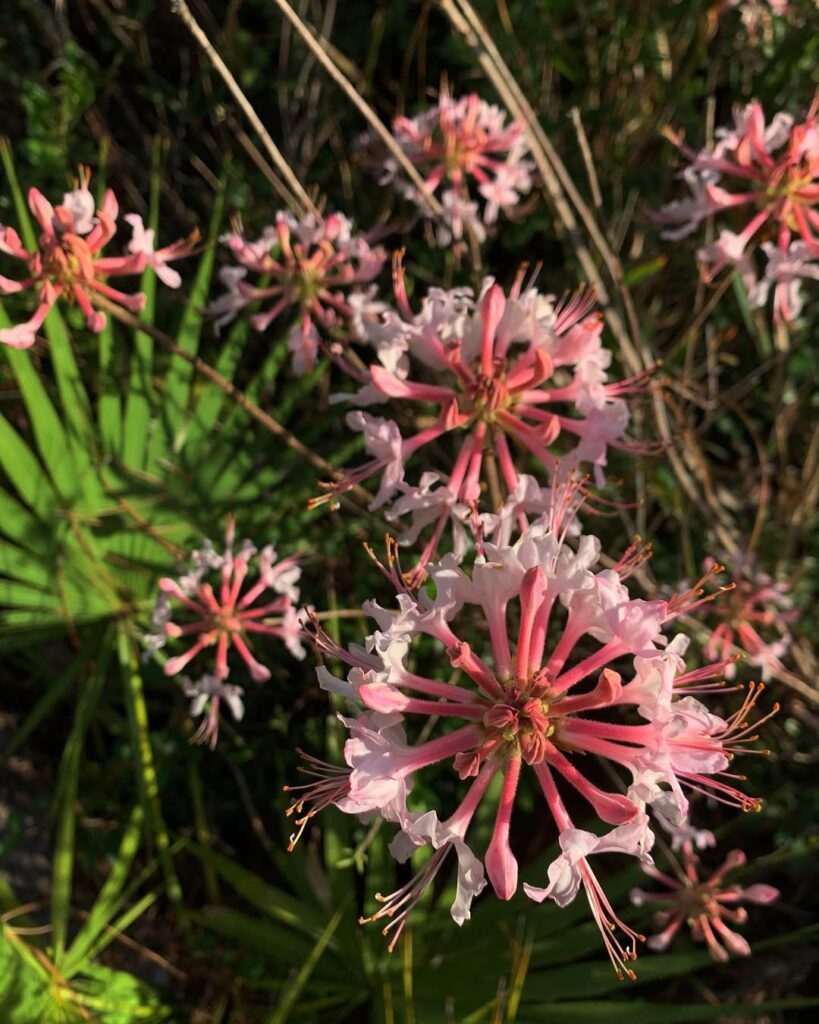
Wild azalea (Rhododendron canescens), also known as Southern pinxter azalea, is the most common native azalea species throughout the Southeastern United States. This deciduous shrub grows 6-15 feet tall and produces showy, fragrant pink or white flowers from March through May that attract hummingbirds and butterflies.
Native to areas from North Carolina to Florida and west to Texas, wild azalea thrives in moist woodland environments and forms large colonies over time. The species name “canescens” refers to the distinctive gray-white hairs found on the undersides of its leaves, making it easily identifiable among native azaleas. The thick, velvety leaves emerge after the spectacular spring blooms and transform to burgundy red in fall, providing additional seasonal interest.
- Hardiness: Zones 6-9, native to Southeastern United States
- Light: Part shade preferred
- Water: Medium water requirements, prefers consistently moist conditions
- Soil: Moist, well-drained, acidic soil (pH below 6.8), no tolerance for calcium carbonate
- Fertilizer: Low requirements, benefits from organic matter in acidic soils
- Pest/Disease Resistance: Generally resistant when grown in appropriate conditions
- Growth Rate: Medium growth rate, forms multi-trunked colonies over time
Selecting the Right Native Plants for Your Garden
How do you choose native plants that’ll thrive in your specific South Carolina garden conditions? Start with plant hardiness zones and assess your soil type, sunlight exposure, and moisture levels. Garden planning begins with understanding whether you’re working with sandy coastal soils or clay-rich piedmont areas.
Consider your maintenance preferences too. Drought-tolerant species like Purple Coneflower require minimal watering, while plants suited for wet areas need consistent moisture. Match bloom times for continuous color throughout seasons.
Measure your available space carefully. Large specimens like Southern Magnolia need 20-30 feet spacing, whereas ground covers can fill smaller areas effectively. Native plants with deep root systems naturally improve soil aeration and help prevent erosion in your landscape.
Frequently Asked Questions
How Much Do Native South Carolina Plants Typically Cost Compared to Non-Native Varieties?
Native plant pricing runs $7.50-$16.95, matching non-native costs perfectly. You’ll find cost comparison shows natives actually save money long-term through reduced maintenance, better survival rates, and lower replacement expenses than exotic varieties.
When Is the Best Time of Year to Plant Native Species?
You’ll find the best planting seasons are fall through winter, specifically October through December. Early fall planting offers seasonal benefits like cooler temperatures and winter establishment before spring’s growing season begins.
How Often Should I Water Newly Planted Native South Carolina Plants?
Like nurturing a newborn, you’ll need consistent care initially. Water newly planted natives every 2-3 days during plant establishment, then shift to weekly deep watering. Adjust watering frequency based on rainfall and soil moisture levels.
Do Native Plants Require Special Fertilizers or Soil Amendments?
You don’t need special fertilizer types for native plants since they’re adapted to local soils. Test your soil pH first – only add lime or amendments if deficiencies exist, as natives typically thrive without routine fertilization.
Where Can I Purchase Authentic South Carolina Native Plants Locally?
You’ll find authentic South Carolina natives at local nurseries like Carolina Wild Native Plant Nursery and Naturescapes. Attend native plant sales hosted by the SC Native Plant Society and farmer’s markets for regionally appropriate selections.
